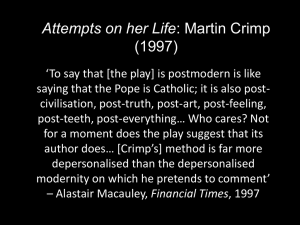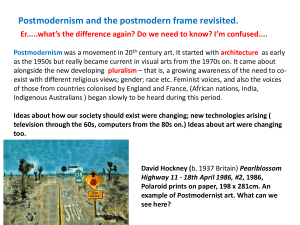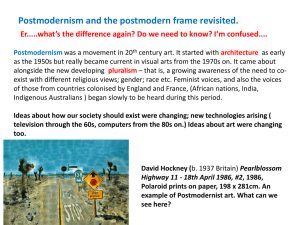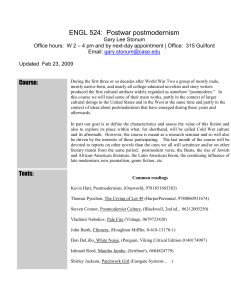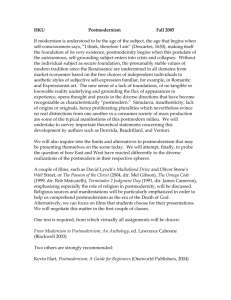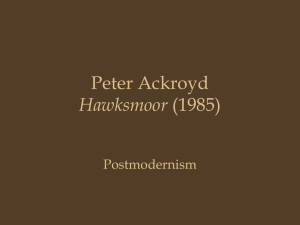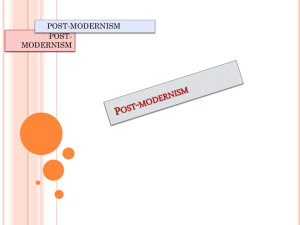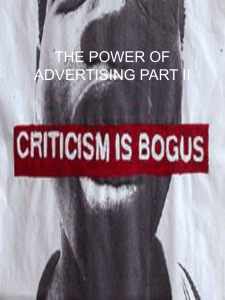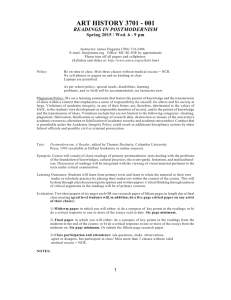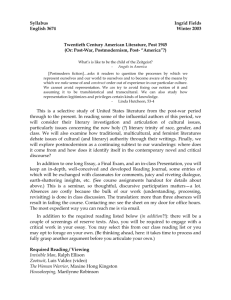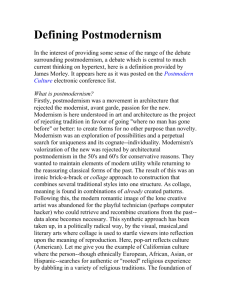THE BODY V - FEMINIST & POSTMODERN BODIES
advertisement
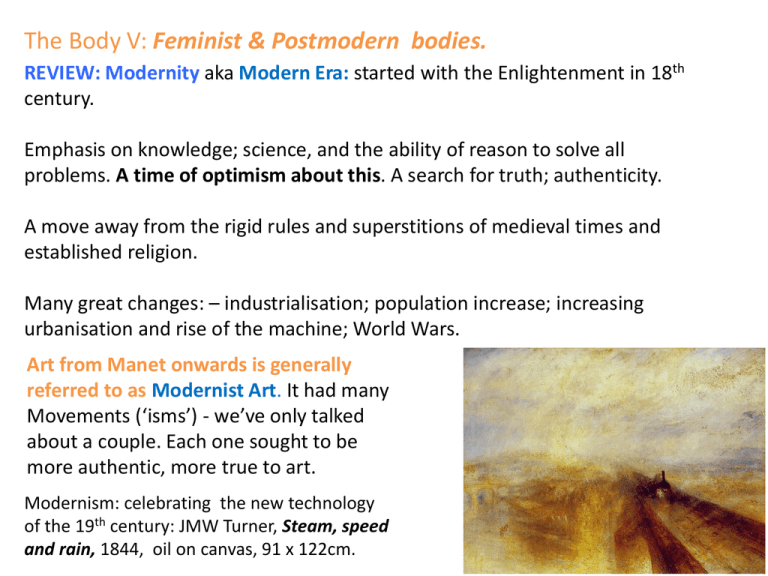
The Body V: Feminist & Postmodern bodies. REVIEW: Modernity aka Modern Era: started with the Enlightenment in 18th century. Emphasis on knowledge; science, and the ability of reason to solve all problems. A time of optimism about this. A search for truth; authenticity. A move away from the rigid rules and superstitions of medieval times and established religion. Many great changes: – industrialisation; population increase; increasing urbanisation and rise of the machine; World Wars. Art from Manet onwards is generally referred to as Modernist Art. It had many Movements (‘isms’) - we’ve only talked about a couple. Each one sought to be more authentic, more true to art. Modernism: celebrating the new technology of the 19th century: JMW Turner, Steam, speed and rain, 1844, oil on canvas, 91 x 122cm. In contrast, Postmodernism questioned whether truth even exists. Postmodernism as an art movement started to take off mid- 20th century. Art reflects what is happening in an artist’s world, and what was happening was a lot of questioning about what Western societies were doing. Postmodernism is all about challenging what has been previously accepted as true – the things Modernism were built on. Feminism was a significant Social Justice issue, among many that were very current at this time. Bruce Nauman, (b. 1941, U.S. ) The true artist helps the world by revealing mystic truths, 1967, fluorescent tubes, MDF backing board 165 x 165cm. One of the key characteristics of Postmodernism was irony. That is, acting as if something is so when you’re trying to say that it isn’t so. Like the text in this image. Up till now, we’ve spent most of our time in Europe. After WW II, the USA became the centre of avant-garde art practice. Now we’ll see more Australian art too… Feminism is a movement seeking to focus awareness on the injustices that women have suffered in Western culture over the centuries. It seeks to make changes in the way we think, and how our society is run. It is a Human Rights movement. The period from the 1960s onwards was a time of many protests about various Human Rights issues: Race (African- Americans; Aust. Aboriginies), Peace Movements (against the Vietnam War); Green movements; Gay rights. Ann Newmarch (Aust., b 1945 )Women hold up half the sky!, 1978, screenprint, 79 x 56cm. This image looks like it is based on a family holiday photo, and is a fun image. The text though, is making an important comment. It is a quote from the great Chinese Communist leader Mao Ze Dong. We may remember Manet and Courbet (Realism) in mid 19th century moving from History Subjects to contemporary ones. Cubist collages of newspapers etc was really a continuation of that. It’s relating to the contemporary, real world. Various materials have meanings for us. Creating a sculpture out of gold would have a different meaning to Macdonald’s wrappers. Traditionally oil paintings were seen as more significant than watercolours; marble was the most noble sculpture material. With Cubism, Surrealism and Dada – all movements of the early 20th century – ephemeral materials such as newspaper, as well as found objects, became a part of art practice. (More on found objects later.) The significance of materials was questioned in Postmodern art. Michelangelo (Italian,1475 – 1564) The Creation of Adam, c.1511-12, fresco on ceiling of Sistine Chapel Barbara Kruger (US, b.1945), Untitled (you invest in the divinity of the masterpiece, 1982, photocopy, 182 X 115cm Barbara Kruger (US, b.1945) has a background in graphic design, working with fashion magazines and book covers. Her artworks incorporate found images with her own text overlaid, generally in black and white and red. The statements she inserts have a brief, punchy nature, which appropriates advertising slogans. She has posted them as billboards and in doing so, they gain a certain power, from their size, position and status. She also sells her artwork on products such as coffee mugs, shopping bags etc. which causes a deliberate, continued confusion between advertising and art. Appropriation is a big part of Postmodernist Art. Here Kruger appropriates the American Flag. It has a long history in Art but during Postmodernism, this trend has increased, often . associated with Irony or Parody. Barbara Kruger Questions, 1991, Photographic silkscreen/vinyl 168 x 236 cm Postmodern art is about showing there is always more than one viewpoint. Traditionally, the viewpoint of straight men was the only viewpoint. Postmodernism (and within this, Feminism) liked to point out that women exist too. Also, gay people and black people, and people from colonised nations. There is no one single truth. Everyone has their own ideas and experience. Nudes and women generally in art were often depicted as ‘available’ to a viewer, assumed ( unconsciously) to be male. This is part of the challenge that Manet’s Olympia threw at us. She may be available (she had to pay the rent!) but it’s not all about you. She was her own person. Kruger considers the subjectivity of women with this image. What is going on here? Barbara Kruger, Untitled (Your gaze hits the side of my face), photocopy, 1981. Guerilla Girls, an American Feminist art collective, use parody here in their appropriation of an Ingres painting to raise awareness of the lack of female artists in a major Art Institution. Parody means ‘sending something up’ by imitating it. This could be any existing idea, or art of the past. Guerilla Girls took names of famous dead women artists as their own, and wore Gorilla Masks when speaking in public. Note the Guerrilla / Gorilla pun (Guerrillas being usually small groups of civilians, fighting organised armies.) Guerrilla Girls, Public Service Announcement poster, mid 1980s, New York. Ingres, Grand Odalisque, 1814. Art of the second half of the 20th century was often politically involved; it questioned the way Society was being run. Screen printing became an important 20th century artmaking technique. Because it is a relatively simple, quick, cheap method for producing multiples of an image, screen printing was used by many community groups for to get political messages across – for purposes of Feminism, Indigenous rights, Vietnam war protests, etc. Marie McMahon (Australian, b. 1953 ) Pay the rent – you are on Aboriginal Land, 19814, screen print,(several versions) 65 × 45 cm
